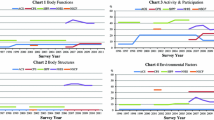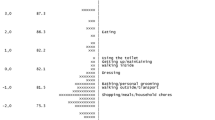Summary
Objectives: Severity and timing are key aspects of disability experience for individuals. They also generate a population’s disability structure (prevalence, counts, patterns). We study links among severity, duration, and structure for community-dwelling adults in the US.
Methods: The data source is the National Health Interview Survey Disability Supplement. Disabilities in personal care (ADL), household management (IADL), and physical functions (PLIM) are analyzed.
Results: Many combinations of disabilities are possible, but just a few are frequent; the top-10 patterns cover 70% of ADL, 89% of IADL, and 47% of PLIM disabled adults. Hierarchical patterns are common for ADLs and IADLs. People with many disabilities also have more-severe ones, and their disabilities often started at the same time.
Conclusions: Disability structure reflects severity and timing of specific disabilities, sometimes strongly, and other times weakly due to exit processes from the community. Assumptions that disability occurs in “hard” tasks first and “easy” ones last, and that hard-and-early connotes mild disability whereas easy-and-late connotes severe, need direct empirical testing.
Similar content being viewed by others
Author information
Authors and Affiliations
Corresponding author
Rights and permissions
About this article
Cite this article
Verbrugge, L.M., Yang, LS. & Juarez, L. Severity, timing, and structure of disability. Soz.-Präventivmed. 49, 110–121 (2004). https://doi.org/10.1007/s00038-004-3058-2
Issue Date:
DOI: https://doi.org/10.1007/s00038-004-3058-2




